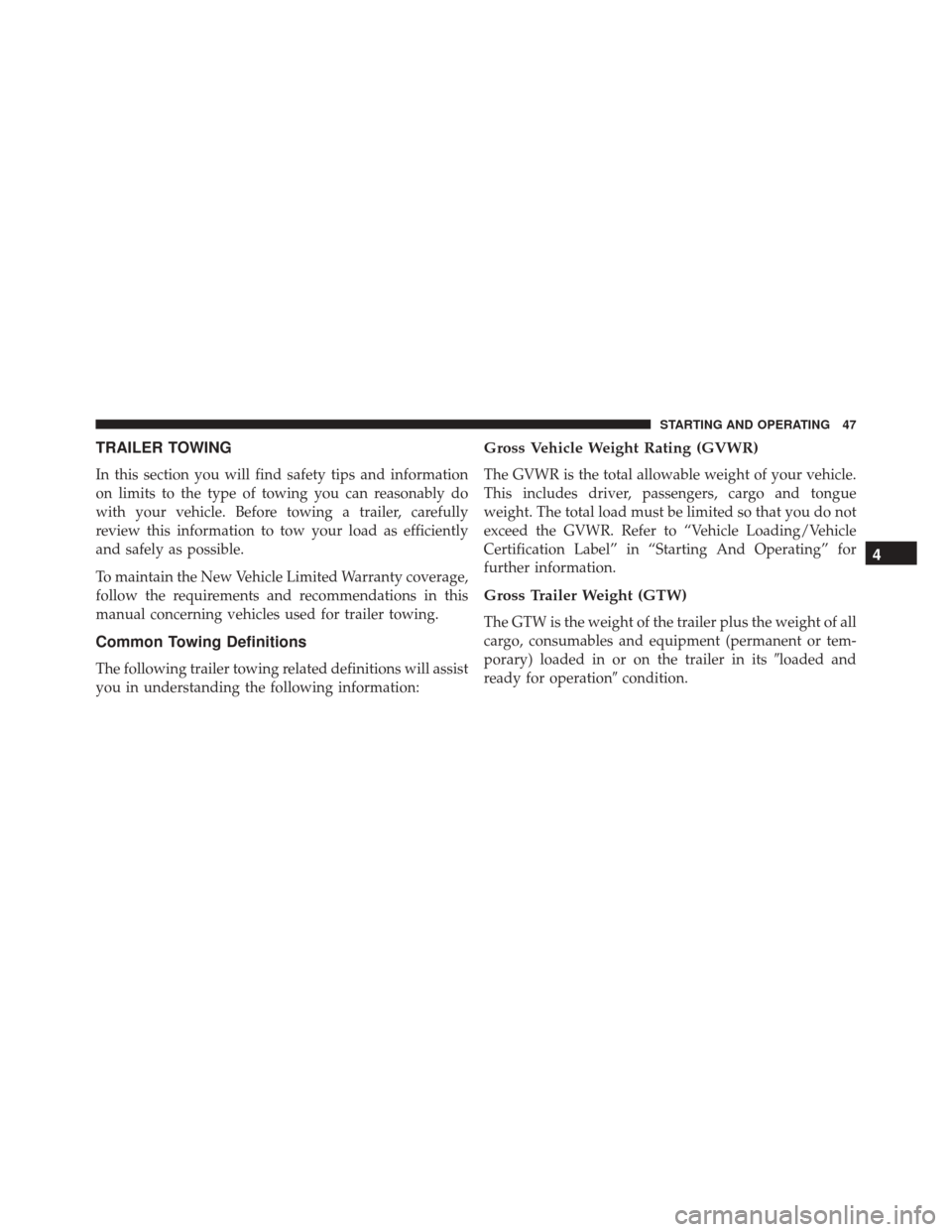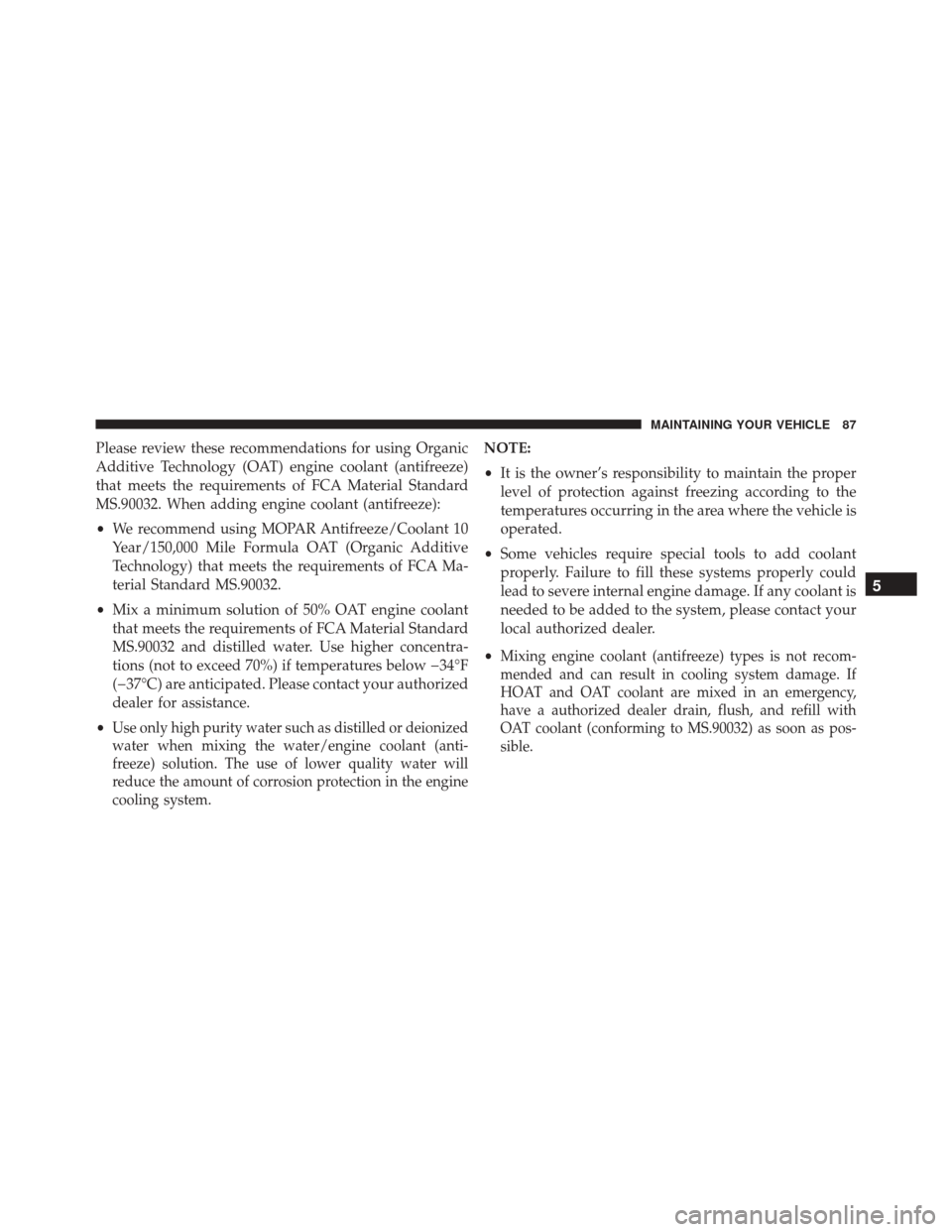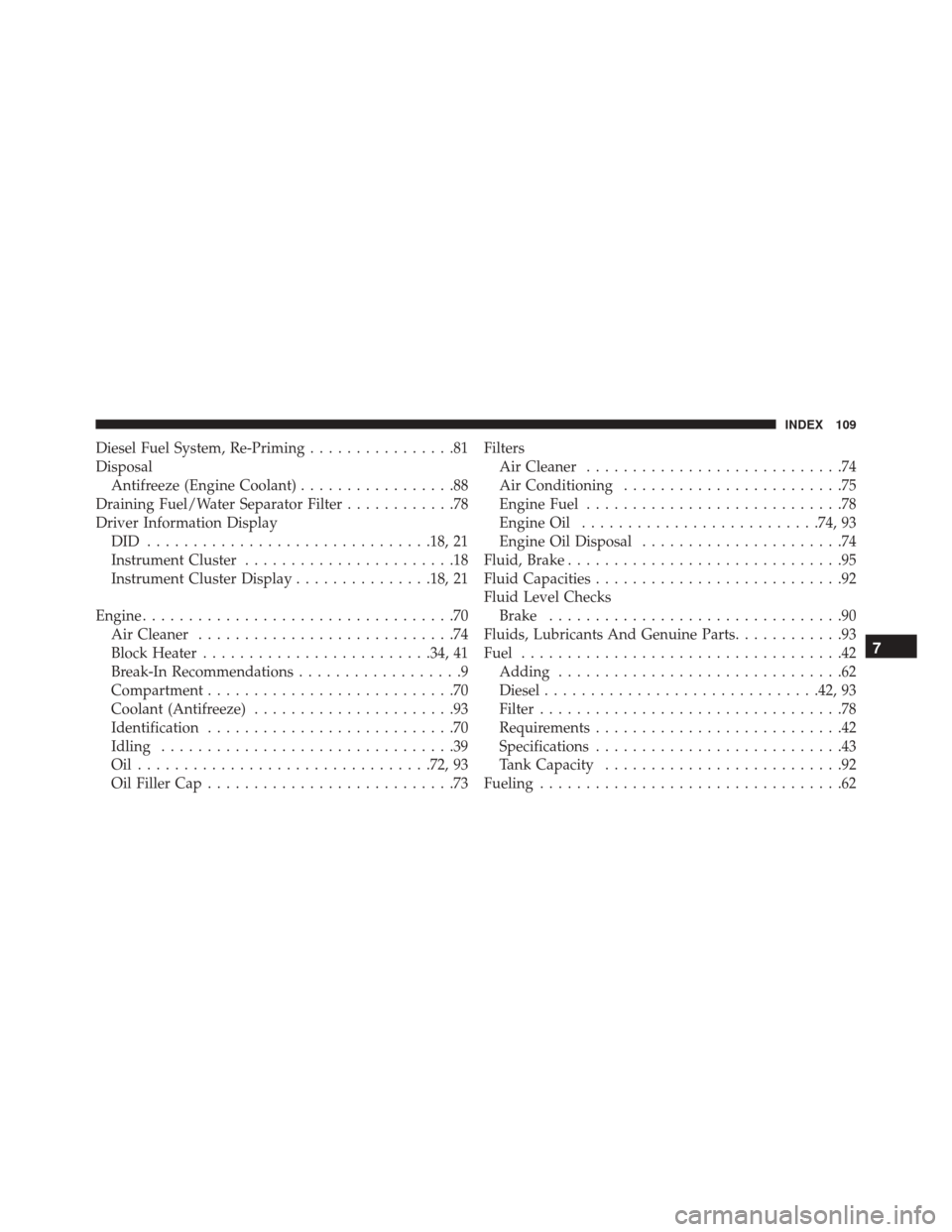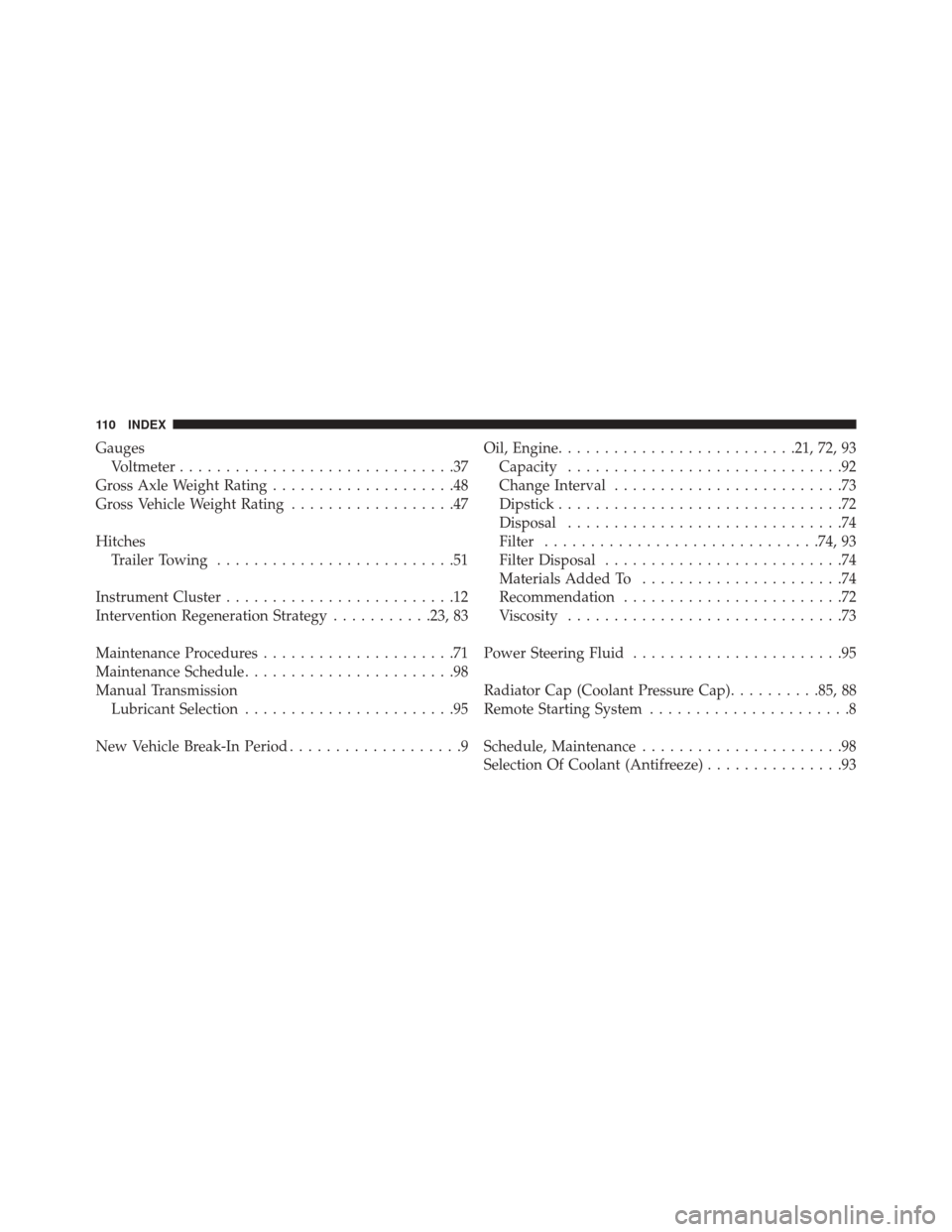Page 9 of 117
THINGS TO KNOW BEFORE STARTING YOUR VEHICLE
CONTENTS
�REMOTE STARTING SYSTEM ...............8
▫ How To Use Remote Start .................8�
ENGINE BREAK-IN RECOMMENDATIONS .....9
2
Page 11 of 117

•Fuel meets minimum requirement
• System not disabled from previous remote start event
• Vehicle security alarm not active
• Water In Fuel Indicator Light is not illuminated
• “Wait To Start” telltale is not illuminated
WARNING!
•Do not start or run an engine in a closed garage or
confined area. Exhaust gas contains Carbon Mon-
oxide (CO) which is odorless and colorless. Carbon
Monoxide is poisonous and can cause serious in-
jury or death when inhaled.
• Keep Remote Keyless Entry (RKE) transmitters
away from children. Operation of the Remote Start
System, windows, door locks or other controls
could cause serious injury or death.
ENGINE BREAK-IN RECOMMENDATIONS
The diesel engine does not require a break-in period due
to its construction. Normal operation is allowed, provid-
ing the following recommendations are followed:
• Warm up the engine before placing it under load.
• Do not operate the engine at idle for prolonged
periods.
• Use the appropriate transmission gear to prevent
engine lugging.
• Observe vehicle oil pressure and temperature indica-
tors.
• Check the coolant and oil levels frequently.
• Vary throttle position at highway speeds when carry-
ing or towing significant weight.
2
THINGS TO KNOW BEFORE STARTING YOUR VEHICLE 9
Page 49 of 117

TRAILER TOWING
In this section you will find safety tips and information
on limits to the type of towing you can reasonably do
with your vehicle. Before towing a trailer, carefully
review this information to tow your load as efficiently
and safely as possible.
To maintain the New Vehicle Limited Warranty coverage,
follow the requirements and recommendations in this
manual concerning vehicles used for trailer towing.
Common Towing Definitions
The following trailer towing related definitions will assist
you in understanding the following information:
Gross Vehicle Weight Rating (GVWR)
The GVWR is the total allowable weight of your vehicle.
This includes driver, passengers, cargo and tongue
weight. The total load must be limited so that you do not
exceed the GVWR. Refer to “Vehicle Loading/Vehicle
Certification Label” in “Starting And Operating” for
further information.
Gross Trailer Weight (GTW)
The GTW is the weight of the trailer plus the weight of all
cargo, consumables and equipment (permanent or tem-
porary) loaded in or on the trailer in its�loaded and
ready for operation� condition.
4
STARTING AND OPERATING 47
Page 89 of 117

Please review these recommendations for using Organic
Additive Technology (OAT) engine coolant (antifreeze)
that meets the requirements of FCA Material Standard
MS.90032. When adding engine coolant (antifreeze):
•We recommend using MOPAR Antifreeze/Coolant 10
Year/150,000 Mile Formula OAT (Organic Additive
Technology) that meets the requirements of FCA Ma-
terial Standard MS.90032.
• Mix a minimum solution of 50% OAT engine coolant
that meets the requirements of FCA Material Standard
MS.90032 and distilled water. Use higher concentra-
tions (not to exceed 70%) if temperatures below �34°F
(�37°C) are anticipated. Please contact your authorized
dealer for assistance.
•
Use only high purity water such as distilled or deionized
water when mixing the water/engine coolant (anti-
freeze) solution. The use of lower quality water will
reduce the amount of corrosion protection in the engine
cooling system.
NOTE:
• It is the owner’s responsibility to maintain the proper
level of protection against freezing according to the
temperatures occurring in the area where the vehicle is
operated.
• Some vehicles require special tools to add coolant
properly. Failure to fill these systems properly could
lead to severe internal engine damage. If any coolant is
needed to be added to the system, please contact your
local authorized dealer.
•
Mixing engine coolant (antifreeze) types is not recom-
mended and can result in cooling system damage. If
HOAT and OAT coolant are mixed in an emergency,
have a authorized dealer drain, flush, and refill with
OAT coolant (conforming to MS.90032) as soon as pos-
sible.
5
MAINTAINING YOUR VEHICLE 87
Page 111 of 117

Diesel Fuel System, Re-Priming................81
Disposal Antifreeze (Engine Coolant) .................88
Draining Fuel/Water Separator Filter ............78
Driver Information Display DID .............................. .18, 21
Instrument Cluster .......................18
Instrument Cluster Display ...............18, 21
Engine ..................................70
Air Cleaner ............................74
Block Heater ........................ .34, 41
Break-In Recommendations ..................9
Compartment ...........................70
Coolant (Antifreeze) ......................93
Identification ...........................70
Idling ................................39
Oil............................... .72, 93
Oil Filler Cap ...........................73 Filters
Air Cleaner ............................74
Air Conditioning ........................75
Engine Fuel ............................78
Engine Oil ......................... .74, 93
Engine Oil Disposal ......................74
Fluid, Brake ..............................95
Fluid Capacities ...........................92
Fluid Level Checks Brake ................................90
Fluids, Lubricants And Genuine Parts ............93
Fuel ...................................42
Adding ...............................62
Diesel ............................. .42, 93
Filter .................................78
Requirements ...........................42
Specifications ...........................43
Tank Capacity ..........................92
Fueling .................................62
7
INDEX 109
Page 112 of 117

GaugesVoltmeter ..............................37
Gross Axle Weight Rating ....................48
Gross Vehicle Weight Rating ..................47
Hitches Trailer Towing ..........................51
Instrument Cluster .........................12
Intervention Regeneration Strategy ...........23, 83
Maintenance Procedures .....................71
Maintenance Schedule .......................98
Manual Transmission Lubricant Selection .......................95
New Vehicle Break-In Period ...................9 Oil, Engine
......................... .21, 72, 93
Capacity ..............................92
Change Interval .........................73
Dipstick ...............................72
Disposal ..............................74
Filter ............................. .74, 93
Filter Disposal ..........................74
Materials Added To ......................74
Recommendation ........................72
Viscosity ..............................73
Power Steering Fluid .......................95
Radiator Cap (Coolant Pressure Cap) ..........85, 88
Remote Starting System ......................8
Schedule, Maintenance ......................98
Selection Of Coolant (Antifreeze) ...............93
110 INDEX